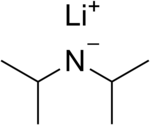Lithium diisopropylamide
 |
|
| Names | |
|---|---|
|
IUPAC name
Lithium diisopropylamide
|
|
| Other names
LDA
|
|
| Identifiers | |
|
3D model (Jmol)
|
|
| ChemSpider | |
| ECHA InfoCard | 100.021.721 |
|
PubChem CID
|
|
|
|
|
|
| Properties | |
| C6H14LiN or LiN(C3H7)2 | |
| Molar mass | 107.1233 g/mol |
| Density | 0.79 g/cm3 |
| Reacts with water | |
| Acidity (pKa) | 36 (THF) |
| Hazards | |
| Main hazards | corrosive |
| Related compounds | |
|
Related compounds
|
Superbases |
|
Except where otherwise noted, data are given for materials in their standard state (at 25 °C [77 °F], 100 kPa).
|
|
|
|
|
| Infobox references | |
Lithium diisopropylamide (commonly abbreviated LDA) is a chemical compound with the molecular formula [(CH3)2CH]2NLi. It is used as a strong base and has been widely accepted due to its good solubility in non-polar organic solvents and non-nucleophilic nature. It is a colorless solid, but is usually generated and observed only in solution.
LDA is commonly formed by treating a cooled (0 to −78 °C) tetrahydrofuran (THF) solution of diisopropylamine with n-butyllithium.
When dissociated, the diisopropylamide anion can become protonated to form Diisopropylamine. Diisopropylamine has pKa value of 36. Therefore, its conjugate base is suitable for the deprotonation of compounds with greater acidity. Importantly, such weakly acidic compounds carbon acids of the type R2CHZ, where Z = C(O)R', CO2R', and CN. Conventional protic functional groups such as alcohols and carboxylic acids are of course readily deprotonated.
Like most organolithium reagents, LDA is not a salt, but is highly polar. It forms aggregates in solution; with the extent of aggregation depending on the nature of the solvent. In THF its structure is primarily that of a solvated dimer. In nonpolar solvents such as toluene, it forms a temperature-dependent oligomer equilibrium. At room temperature trimers and tetramers are the most likely structures. With increasing temperature the aggregation extends to pentameric and higher oligomeric structures.
Solid LDA is pyrophoric, but its solutions are generally not. As such it is commercially available as a solution in polar aprotic solvents such as THF and ether, however for small scale use (less than 50 mmol), it is common and more cost effective to prepare LDA in situ.
...
Wikipedia
